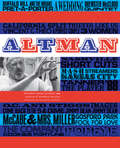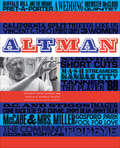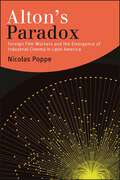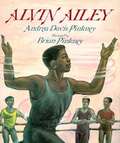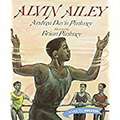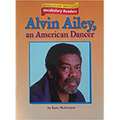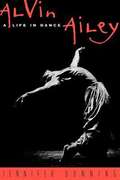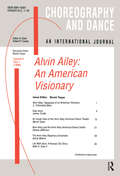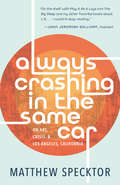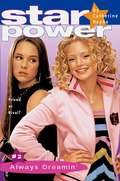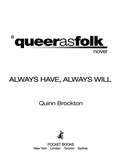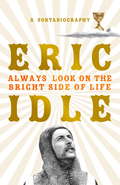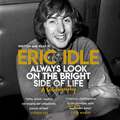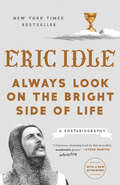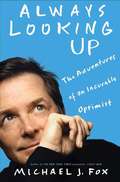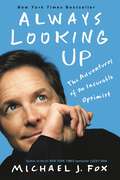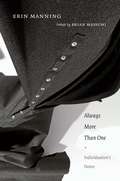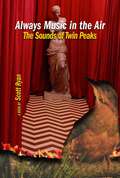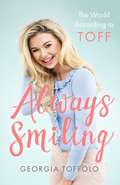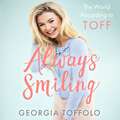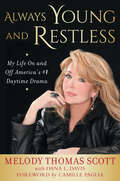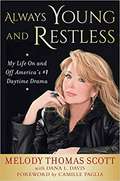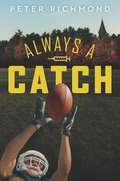- Table View
- List View
Altman
by Kathryn Reed Altman Giulia D'Agnolo VallanFor decades, Robert Altman fascinated audiences with pioneering films—among them M*A*S*H, Nashville, The Player, and Gosford Park—that combined technical innovation with subversive, satirical humor and impassioned political engagement. His ability to explore and engage so many different worlds with a single, coherent vision changed the landscape of cinema forever. This signature "Altmanesque" style is, in the words of Martin Scorsese: "as recognizable and familiar as Renoir's brushstrokes or Debussy's orchestrations." Now, the Altman estate opens its archive to celebrate his extraordinary life and career in the first authorized visual biography on the iconoclastic director. Altman, by Altman’s widow Kathryn Reed Altman and film critic Giulia D’Agnolo Vallan, brims with photographs and ephemera, many culled from private family albums, and personal recollections of the director. Alongside the intimate illustrated story is a complete visual, historical, and critical narrative of Altman’s films and his process. To honor the Altman trademark of using a wide cast of characters, Altman also features contributions from his collaborators and contemporaries including Frank Barhydt, E. L. Doctorow, Roger Ebert, Jules Feiffer, Julian Fellowes, James Franco, Tess Gallagher, Pauline Kael, Garrison Keillor, Michael Murphy, Martin Scorsese, Lily Tomlin, Alan Rudolph, Michael Tolkin, and Kurt Vonnegut Jr.
Altman (Text-Only Edition)
by Kathryn Reed AltmanFor decades, Robert Altman fascinated audiences with pioneering films—among them M*A*S*H, Nashville, The Player, and Gosford Park—that combined technical innovation with subversive, satirical humor and impassioned political engagement. His ability to explore and engage so many different worlds with a single, coherent vision changed the landscape of cinema forever. This signature "Altmanesque" style is, in the words of Martin Scorsese: "as recognizable and familiar as Renoir's brushstrokes or Debussy's orchestrations." Now, the Altman estate opens its archive to celebrate his extraordinary life and career in the first authorized visual biography on the iconoclastic director. Altman, by Altman’s widow Kathryn Reed Altman and film critic Giulia D’Agnolo Vallan, brims with photographs and ephemera, many culled from private family albums, and personal recollections of the director. Alongside the intimate illustrated story is a complete visual, historical, and critical narrative of Altman’s films and his process. To honor the Altman trademark of using a wide cast of characters, Altman also features contributions from his collaborators and contemporaries including Frank Barhydt, E. L. Doctorow, Roger Ebert, Jules Feiffer, Julian Fellowes, James Franco, Tess Gallagher, Pauline Kael, Garrison Keillor, Michael Murphy, Martin Scorsese, Lily Tomlin, Alan Rudolph, Michael Tolkin, and Kurt Vonnegut Jr.
Alton's Paradox: Foreign Film Workers and the Emergence of Industrial Cinema in Latin America (SUNY series in Latin American Cinema)
by Nicolas PoppeAlton's Paradox builds upon extensive archival and primary research, but uses a single text as its point of departure—a 1934 article by the Hungarian American cinematographer John Alton in the Hollywood-published International Photographer. Writing from Argentina, Alton paradoxically argues of cine nacional, "The possibilities are enormous, but not until foreign technicians will take the matter in their hands and with foreign organization will there be local industry." Nicolas Poppe argues that Alton succinctly articulates a line of thought commonly held across Latin America during the early sound period but little explored by scholars: that foreign labor was pivotal to the rise of national film industries. In tracking this paradox from Hollywood to Mexico to Argentina and beyond, Poppe reconsiders a series of notions inextricably tied to traditional film historiography, including authorship, (dis)continuation, intermediality, labor, National Cinema, and transnationalism. Wide-angled views of national film industries complement close-up analyses of the work of José Mojica, Alex Phillips, Juan Orol, Ángel Mentasti, and Tito Davison.
Alvin Ailey
by Andrea Davis Pinkney Brian PinkneyDescribes the life, dancing, and choreography of Alvin Ailey, who created his own modern dance company to explore the black experience. Alvin Ailey is a biography of a brilliant dancer/choreographer as well as the story of the creation of Revelations, his modern dance masterpiece which premiered in New York City in 1960
Alvin Ailey, an American Dancer (Houghton Mifflin Harcourt Vocabulary Readers #Leveled Reader: Level: 4, Theme: 5.2)
by Kate McgovernA brief biography of American dancer Alvin Ailey.
Alvin Ailey: An American Visionary (Choreography and Dance Studies Series #4.1)
by Muriel TopazDuring its three and half decades, the Alvin Ailey Company has left lasting markers on the playing field of American Modern Dance. It has established a reputation for precise but spectacular dancing, for depicting an African American ethos with sensitivity and elegance, and set standards for performance excellence. Ailey's choreography caused shock waves in the dance world of 1958 and continues to move audiences deeply. The company has also provided a paradigm for a modern dance repertory company. Contributors include Jennifer Dunning, Ronni Favors, Allan Gray, Denise Jefferson, Cynthia Sithembile West, Muriel Topaz, James Truitte, and Sylvia Waters. Eulogies written by David Dinkins, Carmen de Lavallade, Judith Jamison and Maya Angelou.
Always Crashing in the Same Car: On Art, Crisis, And Los Angeles, California
by Matthew Specktor"[An] absorbing and revealing book. . . nestling in the fruitful terrain between memoir and criticism." —Geoff Dyer, author of Out of Sheer Rage Blending memoir and cultural criticism, Matthew Specktor explores family legacy, the lives of artists, and a city that embodies both dreams and disillusionment. In 2006, Matthew Specktor moved into a crumbling Los Angeles apartment opposite the one in which F. Scott Fitzgerald spent the last moments of his life. Fitz had been Specktor’s first literary idol, someone whose own passage through Hollywood had, allegedly, broken him. Freshly divorced, professionally flailing, and reeling from his mother’s cancer diagnosis, Specktor was feeling unmoored. But rather than giving in or “cracking up,” he embarked on an obsessive journey to make sense of the mythologies of “success” and “failure” that haunt the artist’s life and the American imagination. Part memoir, part cultural history, part portrait of place, Always Crashing in the Same Car explores Hollywood through a certain kind of collapse. It’s a vibrant and intimate inspection of failure told through the lives of iconic, if under-sung, artists—Carole Eastman, Eleanor Perry, Warren Zevon, Tuesday Weld, and Hal Ashby, among others—and the author’s own family history. Through this constellation of Hollywood figures, he unearths a fascinating alternate history of the city that raised him and explores the ways in which curtailed ambition, insufficiency, and loss shape all our lives. At once deeply personal and broadly erudite, it is a story of an art form (the movies), a city (Los Angeles), and one person’s attempt to create meaning out of both. Above all, Specktor creates a moving search for optimism alongside the inevitability of failure and reveals the still-resonant power of art to help us navigate the beautiful ruins that await us all.
Always Dreamin'
by Catherine HapkaWill all Star's dreams be dashed? The European leg of Star's tour is going well, but Star has begun having strange dreams, and she's convinced they have something to do with her family. Meanwhile, a secret she shares with fellow pop star Jade is leaked to the press and explodes into a media war between the two idols. It seems that Jade and her people will stop at nothing to discredit Star! Star is so depressed and distracted she starts messing up onstage. Can she save her reputation, make things right with Jade, and figure out the real meaning of her dreams before she winds up ruining everything she's worked for?
Always Have, Always Will (Queer as Folk)
by Quinn BrocktonThis popular new line of books follows your favorite Queer as Folk characters on a riveting journey of sexual self-discovery with stories about the beloved characters from the record-breaking Showtime series. USA Today raves, "There's never been anything else like it on TV" -- and there's never been a book series like this. Life after college brings a lot more freedom -- and a lot of new problems. Brian must trade his status as BMOC for the bottom rung of the corporate ladder, while Michael, who has long given up on college, now wonders if he's also given up on his dreams. Emmett visits Pittsburgh to celebrate the spectacular launch of his fashion marketing company in Los Angeles (or so everyone thinks), while Deb adds gay rights advocacy to her juggling act of working at the diner and taking care of her ailing brother, Vic. Like Lindsay -- who experiences life as a struggling artist and true love for the first time -- Deb's about to get more than she bargained for. Add in a secret romance, sexually charged office politics, an over-the-top drag ball, and the arrival of new friends and lovers, and our little gang is tested enough to qualify for postgraduate credit. More than ever before, Michael and Brian find their friendship challenged. As their choices tear them apart, Brian sees that it's Michael he's always loved, and that he always will. But will he tell him before it's too late?
Always Look on the Bright Side of Life: A Sortabiography
by Eric IdleWe know him best for his unforgettable roles on Monty Python - from the Flying Circus to The Meaning of Life. Now, Eric Idle reflects on the meaning of his own life in this entertaining memoir that takes us on a remarkable journey from his childhood in an austere boarding school through his successful career in comedy, television, theatre and film. Coming of age as a writer and comedian during the Sixties and Seventies, Eric stumbled into the crossroads of the cultural revolution and found himself rubbing shoulders with the likes of George Harrison, David Bowie and Robin Williams, all of whom became lifelong friends. With anecdotes sprinkled throughout involving Mike Nichols, Mick Jagger, Steve Martin, Paul Simon and many more, as well as the Pythons themselves, Eric captures a time of tremendous creative output with equal parts hilarity and heart.In Always Look on the Bright Side of Life, named after the song he wrote for Life of Brian which has since become the number-one song played at funerals in the UK, he shares the highlights of his life and career with the kind of offbeat humour that has delighted his audiences for five decades. This is a memoir chock-full of behind-the-scenes stories from a high-flying life featuring everyone from Princess Leia to Queen Elizabeth.
Always Look on the Bright Side of Life: A Sortabiography
by Eric IdleBest known for his unforgettable roles in Monty Python, from the Flying Circus to The Meaning of Life, Eric Idle reflects on the meaning of his own life in this brilliantly entertaining memoir that takes us on an unforgettable journey from his childhood in an austere boarding school through his successful career in comedy, television, theatre and film. Coming of age as a writer and comedian during the Sixties and Seventies, Eric stumbled into the crossroads of the cultural revolution and found himself rubbing shoulders with the likes of George Harrison, David Bowie and Robin Williams, all of whom became lifelong friends. With anecdotes sprinkled throughout that involve other close friends and luminaries such as Mick Jagger, Steve Martin, Paul Simon and Mike Nichols - let alone the Pythons themselves - Eric captures a time of tremendous creative output with equal hilarity and heart. In Always Look on the Bright Side of Life, named after the song he wrote for Life of Brian that has since become the number-one song played at funerals in the UK, he shares the highlights of his life and career with the off-beat humour that has delighted audiences for decades.A legend in his own lunchtime, Eric is the author of many books, some not half bad, some not even a quarter bad. Now he enters his anecdotage as the last word in Python memoirs, and the last of this extraordinary group to tell his story. 2019 marks the fiftieth anniversary of The Pythons, and Eric is celebrating the occasion with this laugh-out-loud memoir, chock-full of behind-the-scenes stories from a high-flying life that features everyone from Princess Leia to the Queen.
Always Look on the Bright Side of Life: A Sortabiography
by Eric IdleWe know him best for his unforgettable roles on Monty Python - from the Flying Circus to The Meaning of Life. Now, Eric Idle reflects on the meaning of his own life in this entertaining memoir that takes us on a remarkable journey from his childhood in an austere boarding school through his successful career in comedy, television, theatre and film. Coming of age as a writer and comedian during the Sixties and Seventies, Eric stumbled into the crossroads of the cultural revolution and found himself rubbing shoulders with the likes of George Harrison, David Bowie and Robin Williams, all of whom became dear lifelong friends. With anecdotes sprinkled throughout involving other close friends and luminaries such as Mike Nichols, Mick Jagger, Steve Martin, Paul Simon, Lorne Michaels, and many more, as well as the Pythons themselves, Eric captures a time of tremendous creative output with equal parts hilarity and heart. In Always Look on the Bright Side of Life, named for the song he wrote for Life of Brian and which has since become the number one song played at funerals in the UK, he shares the highlights of his life and career with the kind of offbeat humour that has delighted his audiences for five decades. The year 2019 marks the fiftieth anniversary of The Pythons and Eric is marking the occasion with this hilarious memoir chock full of behind-the-scenes stories from a high-flying life featuring everyone from Princess Leia to Queen Elizabeth.Written and read by Eric Idle(p) Orion Publishing Group 2018
Always Look on the Bright Side of Life: A Sortabiography
by Eric IdleNEW YORK TIMES BESTSELLER • From the ingenious comic performer, founding member of Monty Python, and creator of Spamalot comes an absurdly funny memoir of unparalleled wit and heartfelt candor—now featuring a new afterword. &“A hilarious, charming book by this incredible, i̶n̶s̶u̶f̶f̶e̶r̶a̶b̶l̶e̶ interesting genius.&”—Steve MartinWe know him best for his unforgettable roles on Monty Python—from the Flying Circus to The Meaning of Life. Now, Eric Idle reflects on the meaning of his own life in this entertaining memoir that takes us on a remarkable journey from his childhood in an austere boarding school through his successful career in comedy, television, theater, and film. Coming of age as a writer and comedian during the Sixties and Seventies, Eric stumbled into the crossroads of the cultural revolution and found himself rubbing shoulders with the likes of George Harrison, David Bowie, and Robin Williams, all of whom became dear lifelong friends.With anecdotes sprinkled throughout involving other close friends and luminaries such as Mike Nichols, Mick Jagger, Steve Martin, Paul Simon, Lorne Michaels, and many more, as well as John Cleese and the Pythons themselves, Eric captures a time of tremendous creative output with equal parts hilarity and heart. In Always Look on the Bright Side of Life, named for the song he wrote for Life of Brian and which has since become the number one song played at funerals in the UK, he shares the highlights of his life and career with the kind of offbeat humor that has delighted audiences for five decades.2019 marked the fiftieth anniversary of The Pythons, and Eric commemorated the occasion with this hilarious memoir chock full of behind-the-scenes stories from a high-flying life featuring everyone from Princess Leia to Queen Elizabeth.
Always Looking Up: The Adventures of an Incurable Optimist
by Michael J. FoxThere are many words to describe Michael J. Fox: Actor. Husband. Father. Activist. But readers of Always Looking Up will soon add another to the list: Optimist. Michael writes about the hard-won perspective that helped him see challenges as opportunities. Instead of building walls around himself, he developed a personal policy of engagement and discovery: an emotional, psychological, intellectual, and spiritual outlook that has served him throughout his struggle with Parkinson's disease. Michael's exit from a very demanding, very public arena offered him the time--and the inspiration--to open up new doors leading to unexpected places. One door even led him to the center of his own family, the greatest destination of all. The last ten years, which is really the stuff of this book, began with such a loss: my retirement from Spin City. I found myself struggling with a strange new dynamic: the shifting of public and private personas. I had been Mike the actor, then Mike the actor with PD. Now was I just Mike with PD? Parkinson's had consumed my career and, in a sense, had become my career. But where did all of this leave Me? I had to build a new life when I was already pretty happy with the old one. Always Looking Up is a memoir of this last decade, told through the critical themes of Michael's life: work, politics, faith, and family. The book is a journey of self-discovery and reinvention, and a testament to the consolations that protect him from the ravages of Parkinson's. With the humor and wit that captivated fans of his first book, Lucky Man, Michael describes how he became a happier, more satisfied person by recognizing the gifts of everyday life.
Always Looking Up: The Adventures of an Incurable Optimist
by Michael J. FoxThere are many words to describe Michael J. Fox: Actor. Husband. Father. Activist. But readers of Always Looking Up will soon add another to the list: Optimist. Michael writes about the hard-won perspective that helped him see challenges as opportunities. Instead of building walls around himself, he developed a personal policy of engagement and discovery: an emotional, psychological, intellectual, and spiritual outlook that has served him throughout his struggle with Parkinson's disease. Michael's exit from a very demanding, very public arena offered him the time-and the inspiration-to open up new doors leading to unexpected places. One door even led him to the center of his own family, the greatest destination of all. The last ten years, which is really the stuff of this book, began with such a loss: my retirement from Spin City. I found myself struggling with a strange new dynamic: the shifting of public and private personas. I had been Mike the actor, then Mike the actor with PD. Now was I just Mike with PD Parkinson's had consumed my career and, in a sense, had become my career. But where did all of this leave Me? I had to build a new life when I was already pretty happy with the old one... Always Looking Up is a memoir of this last decade, told through the critical themes of Michael's life: work, politics, faith, and family. The book is a journey of self-discovery and reinvention, and a testament to the consolations that protect him from the ravages of Parkinson's. With the humor and wit that captivated fans of his first book, Lucky Man, Michael describes how he became a happier, more satisfied person by recognizing the gifts of everyday life.
Always More Than One: Individuation's Dance
by Erin ManningIn Always More Than One, the philosopher, visual artist, and dancer Erin Manning explores the concept of the "more than human" in the context of movement, perception, and experience. Working from Whitehead's process philosophy and Simondon's theory of individuation, she extends the concepts of movement and relation developed in her earlier work toward the notion of "choreographic thinking." Here, she uses choreographic thinking to explore a mode of perception prior to the settling of experience into established categories. Manning connects this to the concept of "autistic perception," described by autistics as the awareness of a relational field prior to the so-called neurotypical tendency to "chunk" experience into predetermined subjects and objects. Autistics explain that, rather than immediately distinguishing objects—such as chairs and tables and humans—from one another on entering a given environment, they experience the environment as gradually taking form. Manning maintains that this mode of awareness underlies all perception. What we perceive is never first a subject or an object, but an ecology. From this vantage point, she proposes that we consider an ecological politics where movement and relation take precedence over predefined categories, such as the neurotypical and the neurodiverse, or the human and the nonhuman. What would it mean to embrace an ecological politics of collective individuation?
Always Music in the Air: The Sound of Twin Peaks
by Scott RyanA first-time-ever exploration of the 290 songs from the entirety of win Peaks, sure to entice fans of the David Lynch-Mark Frost's cult classic that revolutionized TV, with brand-new interviews with Frost and several of the key composers and musicians involved."Where we're from, the birds sing a pretty song and there's always music in the air." When author Scott Ryan (Fire Walk With Me: Your Laura Disappeared, The Last Days of Letterman) heard those words on the television series Twin Peaks in 1990, he wanted to live there as well. Problem was, most of the music that played in Twin Peaks were not released. Only one soundtrack came out from the series, and one from the film. It wasn't until 2011 that director David Lynch and composer Angelo Badalamenti opened the archives and released every track on MP3. These tracks were never officially released and do not stream anywhere today. Ryan interviews band members who performed the songs and music editors and directors from the series and draws from archived interviews with the late Badalamenti and singer Julee Cruise. This book explores all the music that was in the air, from Cruise's 1989 release Floating into the Night through all the Twin Peaks soundtracks, the 2011 online releases called the Twin Peaks Archives, and the releases from Twin Peaks: The Return in 2017. Ryan conducts brand new-Interviews with Dean Hurley (composer for The Return, curator of the Twin Peaks Archive), Tim Hunter (director), Lori Eschler (music editor), David Slusser (composer, music editor), Kevin Laffey (A&R for Julee Cruise), Duwayne Dunham (editor, director), Kinny Landrum, (keyboards) and Al Regni (saxophone). Also included are excerpts from Ryan's 2018 interview with Cruise. Foreword by Brad Dukes (Reflections: An Oral History of Twin Peaks).
Always Smiling: The World According to Toff
by Georgia ToffoloFor fans of Made in Chelsea, I'm a Celeb and Celebs Go Dating, ALWAYS SMILING is the first book from the nation's favourite reality TV star Toff!Everyone loves Toff and she has come a long way since bursting onto our screens on E4's Made in Chelsea in 2014. As the runaway winner of I'm a Celebrity Get Me Out of Here 2017, Toff surprised us all, not least herself, with her positive, happy-go-lucky attitude and kindness to others, no matter what challenge came her way in the jungle. In ALWAYS SMILING, Toff is here to share her experiences, some funny, some sad, some that make her cringe with embarrassment. So whether it is friendships, family dramas, heartbreak and relationships, or how she coped with living her life in front of millions of viewers of Made in Chelsea, Toff reveals how she has learnt to keep a smile on her face, whatever life throws at her. Told with her trademark honesty, humour and endless sense of fun, ALWAYS SMILING is a must-have for any fan.
Always Smiling: The World According to Toff
by Georgia ToffoloFor fans of Made in Chelsea, I'm a Celeb and Celebs Go Dating, ALWAYS SMILING is the first book from the nation's favourite reality TV star Toff!Everyone loves Toff and she has come a long way since bursting onto our screens on E4's Made in Chelsea in 2014. As the runaway winner of I'm a Celebrity Get Me Out of Here 2017, Toff surprised us all, not least herself, with her positive, happy-go-lucky attitude and kindness to others, no matter what challenge came her way in the jungle. In ALWAYS SMILING, Toff is here to share her experiences, some funny, some sad, some that make her cringe with embarrassment. So whether it is friendships, family dramas, heartbreak and relationships, or how she coped with living her life in front of millions of viewers of Made in Chelsea, Toff reveals how she has learnt to keep a smile on her face, whatever life throws at her. Told with her trademark honesty, humour and endless sense of fun, ALWAYS SMILING is a must-have for any fan.
Always Smiling: The World According to Toff
by Georgia ToffoloEveryone loves Toff and she has come a long way since bursting onto our screens on E4's Made in Chelsea in 2014. As the runaway winner of I'm a Celebrity Get Me Out of Here 2017, Toff surprised us all, not least herself, with her positive, happy-go-lucky attitude and kindness to others, no matter what challenge came her way in the jungle. In ALWAYS SMILING, Toff is here to share her experiences, some funny, some sad, some that make her cringe with embarrassment. So whether it is friendships, family dramas, heartbreak and relationships, or how she coped with living her life in front of millions of viewers of Made in Chelsea, Toff reveals how she has learnt to keep a smile on her face, whatever life throws at her. Told with her trademark honesty, humour and endless sense of fun, ALWAYS SMILING is a must-have for any fan.(P)2018 Quercus Editions Limited
Always Young and Restless: My Life On and Off America's #1 Daytime Drama
by Dana L. Davis Melody Thomas ScottThe renowned actress who played Nikki Newman on The Young and the Restless opens up about her sixty-year career in this scintillating memoir.Melody Thomas Scott admits she is nothing like her character on The Young and the Restless, who&’s seen it all in her forty-year tenure on America&’s highest-rated daytime serial. But there&’s plenty of drama beyond her character&’s plotlines. In this captivating memoir, Melody reveals the behind-the-scenes saga of her journey to stardom and personal freedom.As Nikki went from impoverished stripper to vivacious heroine, Melody underwent her own striking transformation, becoming a household name in the process. Raised by her abusive grandmother, Melody acted in feature films with Alfred Hitchcock, John Wayne, and Clint Eastwood—and endured abuse of industry men before taking control of her life and career in a daring getaway move. Melody shares all this, plus juicy on-and-off-set details of what it&’s like to be one half of the show&’s most successful supercouple, &“Niktor.&” In witty, warm prose, readers meet the persevering heart of an American icon. Prepare to be moved by a life story fit for a soap opera star.
Always Young and Restless: My Life On and Off Daytime's #1 Drama
by Melody Thomas ScottMelody Thomas Scott admits she is nothing like her Young and the Restless role, who has seen it all in her forty-year tenure on America’s highest-rated daytime serial. But the high drama, angst, and catastrophes aren’t confined to her character’s plotlines. In this captivating memoir, Melody reveals behind-the-scenes tales of her own riveting journey to stardom. <P><P> As Nikki went from impoverished stripper to resourceful, vivacious heroine―with missteps as gripping as her triumphs―Melody became a household name, enthralling global audiences. Her road to stardom was also her road to personal freedom, marked by an escape fit for cinema. In Always Young and Restless, Melody tells of her troubled, untraditional upbringing for the first time. <P><P> Learn how she suffered at home with her grandmother, a compulsive hoarder, whose cruelty as her guardian is shockingly extreme, and endured abuse at the hands of industry men; what it was like to act in feature films with Alfred Hitchcock, John Wayne, and Clint Eastwood; and how she took control of her life and career in a daring getaway move. And of course, Melody divulges juicy on-and-off-set details of what it’s like to be one half of the show’s most successful supercouple, “Niktor.” In witty, warm prose, meet the shining, persevering heart of an American icon―and prepare to be moved by a life story fit for a soap opera star.
Always a Catch
by Peter RichmondA ripped-from-the-headlines story about teens and steroids. From a New York Times bestselling sports writer comes the story of one boy's quest to stay true to himself without letting down his team. Jack and his father have never seen eye to eye...until Jack's dad gives him the chance to transfer to Oakhurst his junior year. His dad sees it as a way for Jack to get into a good college; Jack sees it as refuge from his dad. Oakhurst is more than an escape--it's a chance for Jack to do something new, to try out for the football team. Once Jack makes the team, he's thrust into a foreign world--one of intense hazing, vitamin supplements, monkey hormones and steroids. Jack has to decide how far he's willing to go to fit in--and how much he's willing to compromise himself to be the man his team wants him to be. Perfect for fans of Mike Lupica and Tim Green. Praise for ALWAYS A CATCH: "Richmond has written an above-average story that will appeal to fans of the genre and authors, such as Mike Lupica and Tim Green."--School Library Journal "A dynamic but thoughtful novel of self-discovery."--Kirkus Reviews
